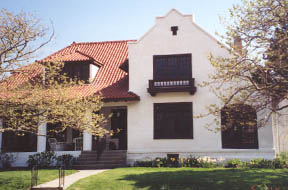Grants to the Museum
In December 2024, we received a $10,000 matching funds grant from the Robert David Lion Gardiner Foundation for new fundraising efforts.

Gardiner Foundation, and Mary Byrnes, our Grant Writer.
Long Beach Historical and Preservation Society (LBHPS) is one of this year’s Preserve New York (PNY) grantees. This grant will fund a professional Building
Condition Report to identify all repair and restoration concerns of our historical landmark buildings. The Preservation League of NYS and their program partners at the New York State Council on the Arts (NYSCA) and the Robert David Lion Gardiner Foundation are thrilled to help fund this important work.
The museum house is in urgent need of repairs, suffering from rotting window and door frames, exterior water damage, a collapsing balcony, roof damage, warping floors, and other structural issues. This assessment will provide the LBHPS Board of Directors with a comprehensive plan and approach to prioritizing the work needed and potential costs. The Report will be completed by Joel Snodgrass, Principal of Steward Preservation Services LLC.
“We are so very grateful to the Preservation League of NYS and program partners for awarding us this grant,” said Mary Byrnes, Board Trustee.
For additional details, here is a link to the full press release on the Preservation League of NY State website.
https://www.preservenys.org/blog/preserve-new-york-grants-2023
Thanks to the support of our County Legislator, Denise Ford, the Long Beach Historical & Preservation Society received a Nassau County Parks Department Grant for our support of cultural, educational, and historical programs. This grant in the amount of $15,650 will be used to repair and restore the windows of the Museum.
We received a grant for services from the Documentary Heritage and Preservation Services for New York State. This strategic planning grant will help us to create a three-year plan for the organization.
The Long Beach Historical Society is a 501 (C) (3) organization.
The Museum House

The Long Beach Historical Museum, a U.S. Dept. of the Interior National Register site, is owned and maintained by the Society as the locale for its headquarters and archive. Purchased by the Society in 1997, the 1909 two-story Craftsman-style house is one of the original Estates of Long Beach summer residence villas. Its white stucco exterior, crowned with a red tile roof is situated on a five lots wide plot, in keeping with the covenants placed by Sen. William Reynolds for the creation of his planned community.
Distinguishing exterior features include the 2002 reconstructed star-shaped pediment peak of the front facade. The decorative brackets of the eaves simulate extended rafters, and the arched doorways that mark what was once the open west porch, now enclose the museum gift shop. The design of the roof on the eastern half indicates a Japanese influence that is also seen in other Estates of Long Beach houses. Sometime prior to 1914, the eastern side of the wrap around porch was enclosed between the columns with sets of French doors. It now serves as an exhibit room.
The floor plan is typical of the early 20th century. The first floor has a living room and dining room to either side of the main hall. The walls have been rehabilitated or refinished with appropriate period-style paint and wallpaper. The original wood trim on the ceilings, walls, windows and doors attest definitively to the Craftsman design period. Of particular note is the original dark Lincrusta (linseed oil, wood pulp fabric) between the wood panels below the plate rail in the dining room. The kitchen, pantry and rear storage room are used by the trustees are not open to the public.
Large stained glass windows are a hallmark of Long Beach Estates architecture and the Historical Museum has several of notable design. A trio of artfully rendered windows admit glorious hues of southern light above the landing of the wide staircase rising from the main hall. Another original can be seen in what was once the butler’s pantry and a newly created one in the powder room adjacent to the gift shop. There are two unusual casement stained glass windows in the second-floor bathroom. One is original, the other a recent copy.
The four bedrooms on the second floor house the archives and work associated with the Society’s mission of historical preservation and education. We are pleased to announce that this year we have rehabilitated and furnished a bedroom and the upstairs bathroom, and it is now available for viewing.
The backyard is furnished with large artifacts of historical importance; an original boardwalk bench, manhole covers, and metal plaques. The pergola floor consists of city street bricks and remnants of the Nassau Hotel. Nestled in the southeast corner where a path leads from the back door of the house is the garage with its chauffeur quarters. It matches the main house and retains a remarkable number of original elements. Beadboard covers the walls and ceiling of the parking area which has a covered grease pit in the center of the floor. Two rooms with windows plus shower and toilet facilities in the main area make up the living quarters.
